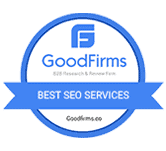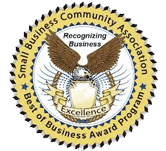Website backlink assessment usually triggers a debate about the required number of backlinks needed to achieve a high position in search results. The answer is not straightforward. Multiple elements determine the way backlinks influence the ranking process although they stand as essential ranking variables. A website requires quality and relevant links from authoritative sources to receive a good evaluation from search engines.
SEO effectiveness requires website owners to build authorized links that originate from trusted sources in their domain. Website authorities need to focus on editorial links instead of utilizing spammy backlinks. Search rankings will improve sustainably when websites maintain natural link-building methods alongside diverse link sources which boost their authority. Read this post to find the answer to “how many backlinks do I need?”
How To Calculate The Perfect Backlink Count For 2025 SEO Success
Each website requires different levels and quantities of backlinks because there exists no universal threshold. Your website’s backlink requirements are based on your niche’s competition level together with the quality of your obtained backlinks.
Hiring guest posting services is essential for building a strong backlink profile, as it helps build high-quality, relevant links from authoritative websites that boost your site’s SEO and online visibility.
Website ranking improvements in moderately competitive search results require about 40-50 high-quality backlinks according to current data and experienced analysis. Backlinks to the top keyword groups like “best credit cards” or “car insurance” require substantially higher numbers compared to other keywords. Your ranking success in such competitive scenarios requires at least 100 trusted backlinks from authoritative sources.
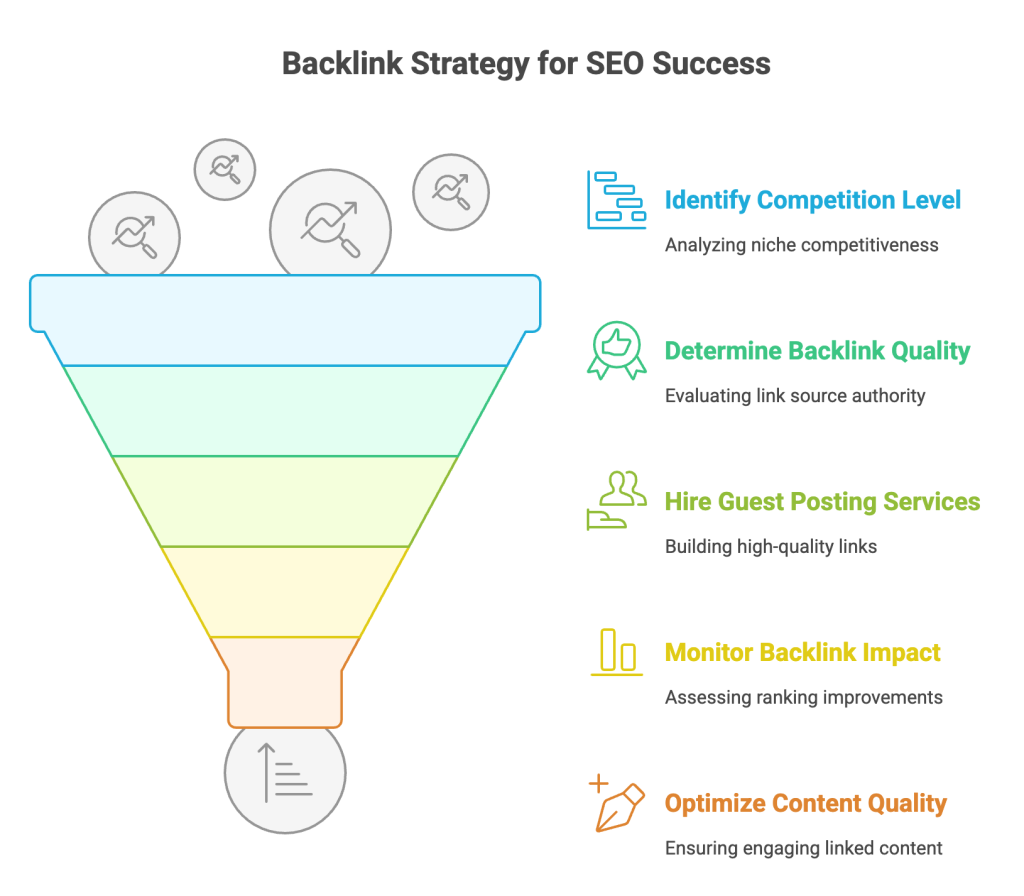
Some pages achieve first-place rankings with just 5-10 exceptional high-quality backlinks, but it’s important to understand that these cases are rare. The influence of linking domains depends on their authority within the industry. Managing affiliated websites can sometimes disproportionately affect rankings in Google search results.
The fundamental value of backlinks for search engine exposure depends directly on the quality of content your links connect to. The work devoted to backlinks along with the resources used to develop them will become useless if the linked page provides insufficient or unengaging content. Focus your content creation on genuine service for your audience because this approach will produce the most effective results from your backlink strategy.
Also Read: New Study Reveals Websites Need 1000+ Backlinks to Succeed
How Backlinks Are Shaping SEO Strategies In 2025
Google’s John Mueller ranks backlinks among the three primary ranking factors while also placing content quality and RankBrain as fundamental factors. Modern backlink assessment conducted by Google operates under completely different principles.
Quality and relevance together with authority criteria have replaced quantity as the main factors in Google ranking systems. The modification fits within Google’s continuous effort to show users reliable search results of high value.
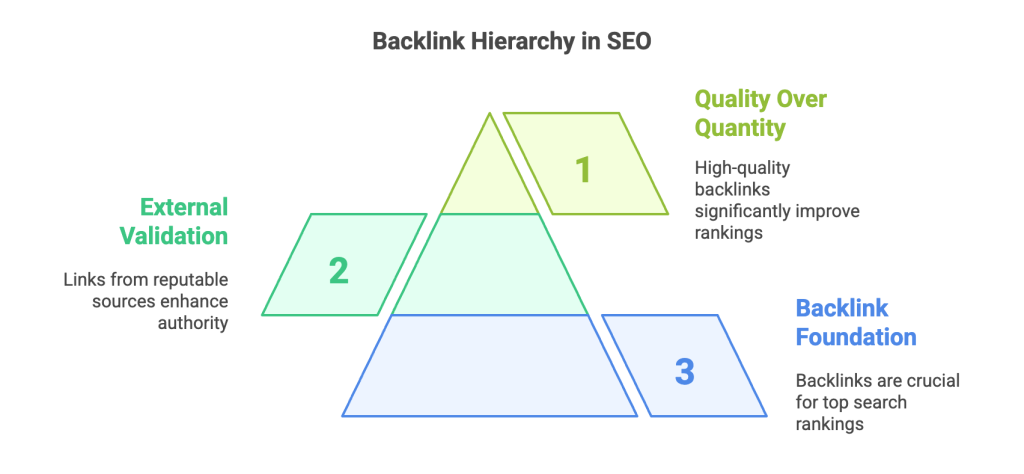
- Backlinks and Top Rankings: Pages ranking in positions 1-3 for 10,000 keywords were found to have nearly four times as many backlinks as those in positions 4-10. This highlights the continued importance of backlinks in achieving top rankings, but it also suggests that the quality of these links plays a significant role in differentiating the top performers from the rest.
- The Power of External Backlinks: A staggering 94% of pages holding the #1 position possesses at least one external backlink. This statistic reinforces the idea that external validation—through links from reputable sources—remains a critical factor in establishing authority and trustworthiness in the eyes of search engines.
- Strengthening Correlation: The correlation between high-quality backlinks and improved rankings has strengthened significantly, now standing at 0.74. This indicates a clear and measurable relationship between the acquisition of authoritative, relevant backlinks and higher search engine rankings.
Google has developed advanced methods to evaluate backlinks. The backlink strength of respected niche-relevant websites exceeds multiple low-quality links. The updated SEO approach now values authentic partnerships and first-rate content with various appropriate links to deliver efficient ranking results.
Google’s algorithm evolution demonstrates why a strategic link-building approach remains essential for SEO success. Strategic link-building requires professionals to make authoritative relationships and produce natural link-attracting content while comprehending the contextual purposes of sites that link. Backlinks gain meaning to boost a website’s authority rankings when implemented according to proper practices.
Essential Insights Into Backlink Building
To understand what constitutes a quality backlink in 2025, it’s essential to break it down systematically. A quality backlink is akin to forming a meaningful connection—it should come from a source that aligns with your niche, holds credibility, and adds genuine value.
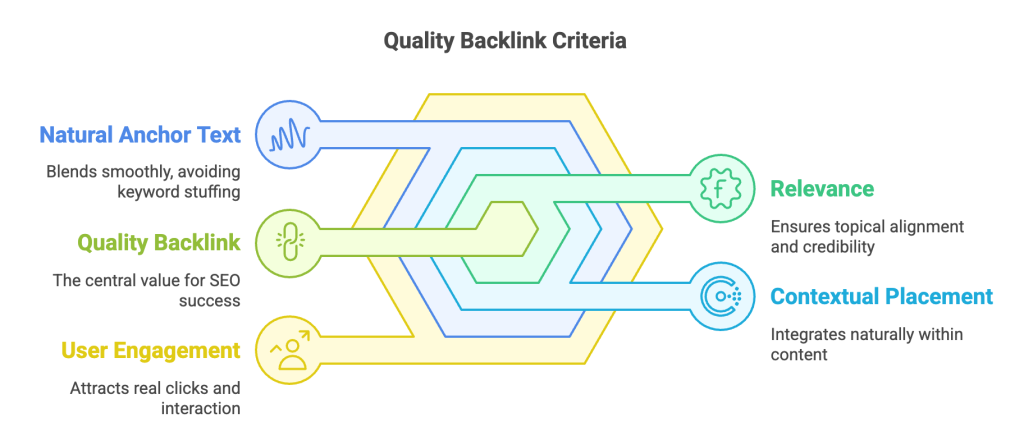
A high-quality backlink in 2025 must meet the following criteria:
- Relevance: A backlink from a website within your industry carries more weight because it signals topical alignment. For example, a link from a tech blog to a software company is more impactful than one from a fashion site, as it reflects expertise and relevance.
- Contextual Placement: The backlink should fit naturally within the content, enhancing the reader’s understanding. Forced or irrelevant placements can appear spammy and diminish the link’s value, while a well-integrated link adds credibility and context to the discussion.
- Natural Anchor Text: Anchor text should blend smoothly into the content, avoiding keyword stuffing or awkward phrasing. Natural anchor text improves user experience and aligns with search engine guidelines, ensuring the link appears organic and trustworthy.
- User Engagement: A quality backlink attracts clicks from real users who find it useful. High engagement indicates the link’s relevance and value, signaling to search engines that it contributes meaningfully to the content and enhances the user’s experience.
- Domain Authority: The linking website’s authority matters. A backlink from a high-authority, trusted domain carries more weight because search engines view it as a credible endorsement. This trust translates into greater value for your website’s ranking and visibility.
Link equity serves as an essential yet commonly misunderstood principle which experts refer to as “link juice.” A website resembles a city water distribution network where quality backlinks function as valuable reservoirs. Authoritative linking sources with big and durable reservoirs supply significant value to your website at the same time they improve its authority rankings in search engines.
Backlinks in 2025 gain their value from the combination of source trustworthiness along with contextual relevance and content targeting. Combined elements determine the performance impact of backlinks for your website since they establish meaningful contributions to search engine rankings alongside site credibility.
Fundamental Components Guiding Your Backlink Approach
The evaluation of your backlink strategy begins from this point forward. Every business maintains a different operational scale that determines its necessary backlink requirements. A local small bakery requires different resources compared to the multinational corporation Starbucks. The effectiveness of your website backlink strategy depends on its size together with your organizational goals and industry competition standards.
Begin by analyzing your overall website clout for proper assessment. Domain authority (DA) acts as a site credibility indicator by serving as your website’s credibility score. Websites with higher DAs require fewer backlinks to achieve good search results yet websites with lower DAs need to focus on multiple quality backlinks for developing trust and search engine optimization.
Key Principles For Establishing Strong Backlinks
This is where the strategy demonstrates its effectiveness. I will explain an approach that is delivering significant results in 2025.
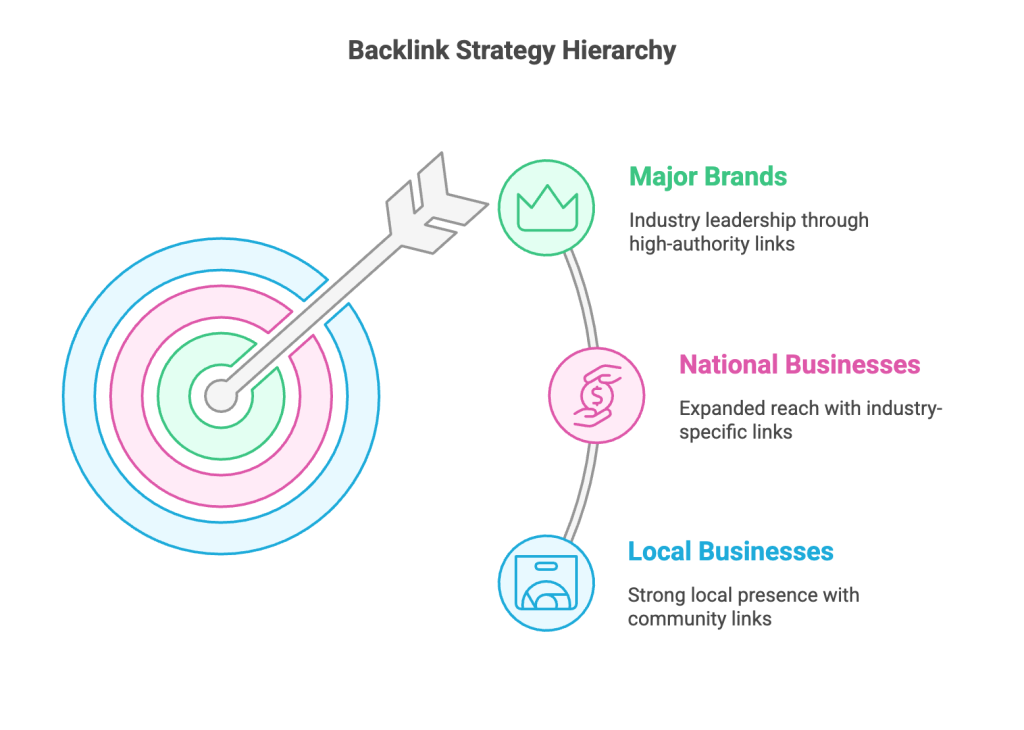
Backlinks Your Homepage Needs To Dominate Search Rankings
The homepage acts as the digital front door to a business, forming the first impression for its audience. A well-optimized homepage establishes credibility, builds trust, and attracts visitors. Implementing a strategic link-building approach, aligned with the business’s scale—local, national, or major brand—strengthens authority and visibility, ensuring the homepage supports business objectives.
For Local Businesses: Building A Strong Local Presence
Local businesses should focus on 50-100 referring domains from credible and relevant sources. This helps establish a strong local footprint and builds trust within the community. Key strategies include:
- Reputable Local Business Directories: List your business on well-regarded local directories, ensuring they are credible and avoid low-quality or spammy platforms. Examples include Google My Business, Yelp, and industry-specific directories.
- Chamber of Commerce Websites: Being listed on your local Chamber of Commerce website adds legitimacy and connects you with other businesses in your area.
- Local News Outlets and Coverage: Seek opportunities for coverage in local newspapers, blogs, or radio stations. Positive press mentions can significantly boost your visibility.
- Sponsorships of Community Events: Sponsoring local events, such as charity runs or festivals, not only supports your community but also earns you valuable backlinks from event organizers and participants.
- Memberships in Professional Associations: Joining local or regional professional associations can lead to mentions on their websites, further enhancing your credibility.
For National Businesses: Expanding Your Reach
National businesses should aim for 100-300 referring domains, focusing on sources that align with their industry and target audience. This broader approach helps establish authority on a larger scale. Effective tactics include:
- Industry-Specific Directories: Listing your business in niche directories relevant to your sector can drive targeted traffic and improve your search engine rankings.
- Meaningful Press Releases: Distributing well-crafted press releases about significant company milestones, product launches, or partnerships can earn coverage in national media outlets.
- Speaking Engagements at Relevant Events: Participating as a speaker or panelist at industry conferences or webinars can lead to mentions and backlinks from event organizers and attendees.
- Industry Awards and Recognitions: Applying for and winning industry awards not only boosts your reputation but also often results in backlinks from award-granting organizations.
- Collaborations with Partner Websites: Partnering with complementary businesses or influencers in your industry can lead to mutually beneficial link exchanges and increased exposure.
For Major Brands: Establishing Industry Leadership
Major brands should strive for 300+ referring domains, focusing on high-authority sources that reinforce their position as industry leaders. This requires a more ambitious and strategic approach, including:
- Coverage in National Press Outlets: Securing features or mentions in prominent national publications, such as Forbes, The Wall Street Journal, or industry-specific magazines, can significantly enhance your brand’s authority.
- High-Authority Business Listings: Ensure your brand is listed on reputable business directories like Bloomberg, Crunchbase, or industry-specific platforms.
- Mentions as an Industry Leader: Position your brand as a thought leader by contributing expert insights, research, or commentary to high-profile publications and websites.
- Initiatives Related to Corporate Social Responsibility (CSR): Highlighting your brand’s CSR efforts, such as sustainability initiatives or charitable partnerships, can earn backlinks from organizations and media outlets covering these topics.
- Citations in Research Studies and Publications: Collaborating with academic institutions or research organizations to contribute data or insights can lead to citations in studies, white papers, or reports, further solidifying your authority.
Aligning Strategy With Business Goals
Align link-building with your goals for success. Local businesses need community trust, national ones require industry relevance, and major brands should focus on authority. Quality matters more than quantity—prioritize reputable links, stay ethical, and monitor progress to strengthen your homepage, boost rankings, and leave a lasting impact.
How Many Backlinks Your Resource Pages Truly Need To Rank
Building authority together with organic link acquisition starts with creating Essential Power pages known as Resource pages. These web pages deliver extraordinary worth which proves attractive to the industry peers. Your brand develops authority through deep actionable content which makes visitors trust your source so they link back to your site thus strengthening your professional industry position.
Resource pages require their development to begin with original research that includes industry studies. The analysis uses proprietary information to survey at least 100 participants to reach statistical significance. Work with experts along with academic institutions to boost credibility while using charts, infographics, and graphical displays to make content more attractive for viewers and convenient to share.
Feedback from the field can serve as an effective resource. To establish expert authority the content must cover complete topics beyond 3000 words with additional expert quotes. The content becomes easier to read when you implement diagrams together with custom-made graphics. The content value stays strong through time thanks to regular updates while resource materials are ready for download as PDFs or templates.
Tools that provide interactivity combined with calculators contribute significant value to content. The business should build practical tools that address existing industry problems. Create simple embedding mechanisms that also come with step-by-step user guidance. Users can access basic and advanced versions of your products according to their requirements along with regular updates based on end-user suggestions to improve application functionality.
Resource pages built around research guides and tools can establish your authority in the industry by attracting links from the domain. Your role as a trusted leader in your field will become established through exceptional value-based content delivery and accurate information alongside audience-derived content evolution.
How Many Backlinks Drive Real Results For Your Money Pages
Money pages which serve as service or product pages function as critical conversion-driving elements on your website. These pages need a link-building plan that must maintain proper authority together with relevance and trust signals. When correctly implemented this method helps businesses attract their target audience and deliver performance success toward their business goals.
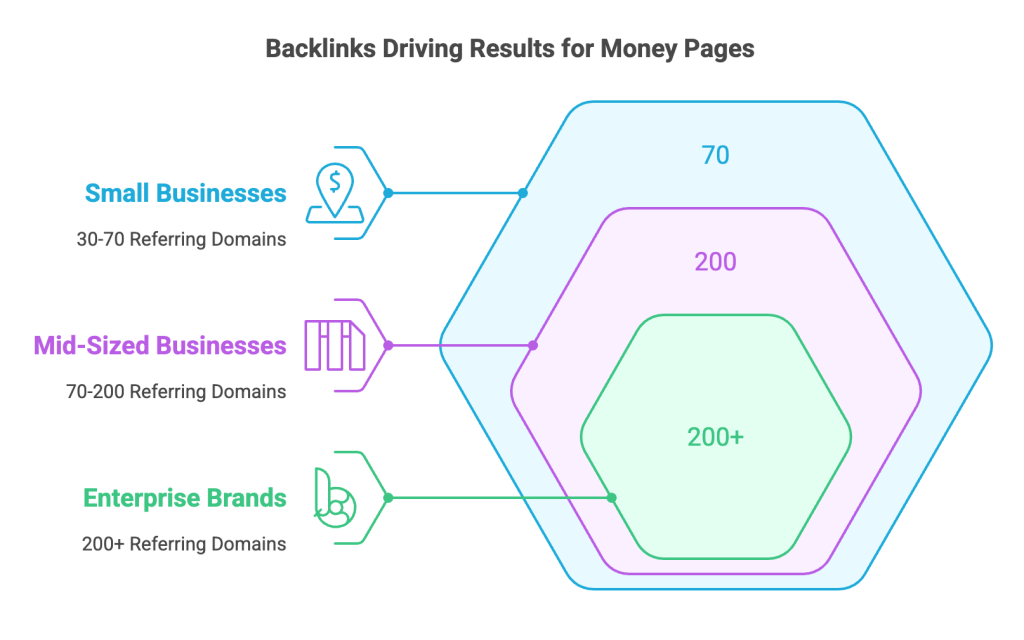
Building brand authority stands as the focus for homepages but money pages demand links that are both extremely relevant and exceptionally high quality. The linking process must happen through relevant sources that match the page content according to its objective. The specific targeting results in superior search positions while building the credibility of the page.
Quality link-building that focuses on relevance enables money pages to generate substantial improvements in conversion rates. Your pages will perform better both in rankings and audience engagement when following proper strategy implementation. This leads to relevant business benefits.
Small Businesses (Local SEO Focus) → 30-70 Referring Domains
- Citations from regional directories targeting local audiences: Listing your business in local directories enhances visibility in area-specific searches, ensuring your brand appears in local results and maps, driving foot traffic and online engagement.
- Collaborative efforts with nearby businesses: Partnering with local businesses for cross-promotions or guest features builds community connections, fosters trust, and drives mutual traffic, benefiting both parties.
- Reviews and endorsements on partner platforms: Positive testimonials on partner websites enhance credibility, attract potential customers through trusted recommendations, and improve local search rankings.
- Contributions to blogs focused on local industries: Writing for local blogs or participating in interviews establishes authority, earns backlinks, and positions your business as a local industry expert.
- Backlinks from community events or nonprofit sponsorships: Sponsoring local events or charities generates backlinks from their websites, boosting local SEO while supporting community initiatives.
Mid-Sized Businesses (National SEO Focus) → 70-200 Referring Domains
- Publishing posts on authoritative industry websites with relevant links: Guest posting on reputable blogs with contextual links drives referral traffic, builds authority, and improves search rankings for targeted keywords.
- Providing expert insights through journalist query platforms: Contributing expert opinions via platforms like HARO secures mentions in high-authority publications, enhancing brand visibility and earning quality backlinks.
- Creating detailed guides and comparison pages for niche audiences: Developing comprehensive resources or comparison posts positions your brand as a go-to source, attracting organic traffic and earning backlinks.
- Partnering with influencers for endorsements and collaborative content: Collaborating with influencers for reviews or co-created content expands reach, builds trust, and generates referral traffic from their audiences.
- Participating in online events and earning links from their promotional pages: Appearing in webinars or podcasts and securing backlinks from event pages boosts visibility and strengthens your brand’s online presence.
Enterprise-Level & eCommerce Brands → 200+ Referring Domains
- Partnering with affiliates and securing spots in curated product lists: Affiliate partnerships and inclusion in “best-of” lists drive referral traffic, improve domain authority, and increase sales through trusted recommendations.
- Sponsoring high-profile platforms within the industry: Sponsorships on major industry websites provide exposure, generate high-quality backlinks, and enhance brand credibility among target audiences.
- Engaging in joint campaigns and earning mentions from reputable brands: Co-marketing campaigns with established brands amplify reach, build trust, and secure valuable backlinks from authoritative sources.
- Establishing scholarship programs to attract links: Offering scholarships and earning backlinks from educational institutions or related platforms boosts SEO while supporting social responsibility initiatives.
- Publishing research-based content and authoritative industry reports: Sharing data-driven insights and thought leadership content in reputable publications establishes authority, attracts organic traffic, and earns high-quality backlinks.
Building Money Pages That Deliver Results Through Quality
Backlinks to money pages require thoughtful planning since PBNs along with link farms and spammy directories must be avoided. Such links can harm credibility. The acquisition of backlinks from reputable sources that place their links editorially will help build your website authority and trust together.
Forcing backlinks directly to money pages should never be practiced. Establish resource pages with high authority to naturally draw valuable organic hyperlinks. Links directed from these pages toward your money pages should emerge naturally as part of an approach that search engines support.
Multiple strategies that link back to your pages from different sources will enhance the effectiveness of your money pages. The internal connection between resource pages and money pages establishes an organic flow of authority between them. The approach fits the guidelines of search engines thus boosting user trust and leading to better long-term search engine rankings.
Building A Content Framework That Drives Real Impact
Many websites underestimate the importance of supporting content. It is not merely filler material; it is the foundation of a robust link-building strategy. To ensure your website performs well in search rankings and provides value to users, the following elements must be prioritized:
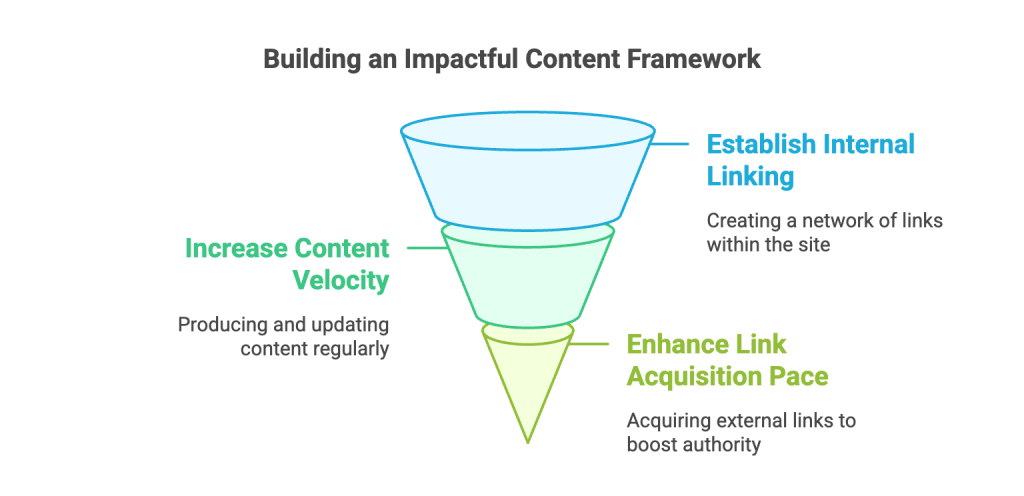
Internal Linking Structure
A well-organized internal linking system is critical for both user experience and SEO. Implement a content hub model that includes:
- Link Main to Subtopic Pages: Connecting main topics to subtopics creates a clear content hierarchy. This improves contextual relevance, helps search engines understand your site’s structure, and enhances user navigation by guiding them to related information seamlessly.
- Cross-Link Related Content: Cross-linking between related posts or pages ensures users and search engines can easily find interconnected information. This practice boosts engagement, reduces bounce rates, and strengthens the topical authority of your website.
- Logical Navigation Hierarchy: A logical navigation structure organizes content into categories and subcategories, making it intuitive for users to explore. This clarity improves user experience and helps search engines index your site.
- Efficient Link Equity Distribution: Link equity, or the value passed through links, should flow to key pages. By strategically linking to important content, you ensure these pages gain authority, improving their chances of ranking higher in search results.
- Three-Click Accessibility Rule: Ensuring critical pages are no more than three clicks away from the homepage enhances accessibility. This improves user experience and ensures search engines can easily crawl and prioritize your most valuable content.
Content Velocity
- Consistent Blog Publishing: Publishing 2-4 high-quality blog posts monthly maintains audience engagement and relevance. It signals to search engines that your site is active, boosting visibility and authority over time.
- Quarterly Power Pages: Creating one comprehensive power page each quarter targets high-value keywords and topics. These pages serve as authoritative resources, driving organic traffic and supporting link-building efforts.
- Monthly Content Audits: Conducting monthly content audits ensures information is accurate and up-to-date. This process improves SEO performance, enhances user experience, and keeps your content aligned with current trends.
- Timely News Coverage: Incorporating relevant news coverage positions your site as a current and authoritative source. It builds trust with your audience and strengthens your website’s credibility in your industry.
- Seasonal Content Planning: Planning seasonal content aligns with trends and user interests. It ensures timely, high-quality posts that capture attention and drive traffic during key periods.
Link Acquisition Pace
- Gradual Authority Building: Acquire 2-3 high-quality backlinks monthly for key pages to build authority steadily. This approach ensures sustainable growth, avoids search engine penalties, and strengthens your site’s credibility over time.
- Diverse Link Profile: Diversify link sources and anchor texts to maintain a natural profile. This prevents over-optimization, reduces the risk of penalties, and ensures your backlinks appear organic and trustworthy to search engines.
- Consistent Outreach Efforts: Engage in regular outreach to connect with relevant websites and influencers. Consistency builds trust, increases collaboration opportunities, and helps secure high-quality backlinks that enhance your site’s authority.
- Industry Relationship Building: Build and nurture relationships within your industry to foster organic link opportunities. Strong connections with peers and influencers often lead to natural backlinks and long-term collaboration benefits.
- Competitor Link Monitoring: Monitor competitor link velocity to benchmark progress and identify improvement areas. Analyzing their backlink acquisition helps refine your strategy and ensures your efforts remain competitive and effective.
How To Strategically Decide On Your Backlink Volume
Backlink building works best when you know where you want to go first. If you do not have a strategy your time and resources will not produce effective results. Your results will grow when you stay on track since you will use your strategy to guide your actions.
Start by evaluating your current situation. Check your website backlink quality using Ahrefs or Semrush platform. Understanding your present situation helps you detect spots that require development. The examination serves as a vital health test that reveals what your site needs improvement on and shows its good qualities.
- Referring Domains: Identify how many unique domains are linking to your site. This metric reflects the breadth of your backlink profile and its reach across the web.
- Domain Authority: Measure your site’s authority score, which indicates its potential to rank. A higher score suggests stronger credibility and trustworthiness.
- Top-Linked Pages: Determine which pages attract the most backlinks. These pages often contain valuable content that resonates with audiences and earns organic links.
Build a Competitor Backlink Matrix to see what backlink strategies they use. Examine your competitor’s most performing webpage results combined with a review of their accepted linking sites and different content types that attract backlinks. This review shows you successful approaches in your specific market field and lets you establish workable performance markers.
- Linking Domains: Note the average number of domains linking to your competitors’ pages. This helps you gauge the level of effort required to compete.
- Domain Quality: Assess the quality scores of these domains. High-quality links from authoritative sites carry more weight and significantly impact rankings.
- Content Types: Identify the formats (e.g., blogs, guides, infographics) that attract the most backlinks. This reveals what content resonates with your target audience.
For instance, a fitness industry client targeting “best protein powder for weight loss” found top-ranking pages had 87, 92, and 73 linking domains, with average domain ratings of 65, 58, and 61. Competing requires 80-90 high-quality backlinks, but quality, relevance, and diversity are equally vital for sustained rankings in competitive niches.
Developing A Strong And Organic Link Profile
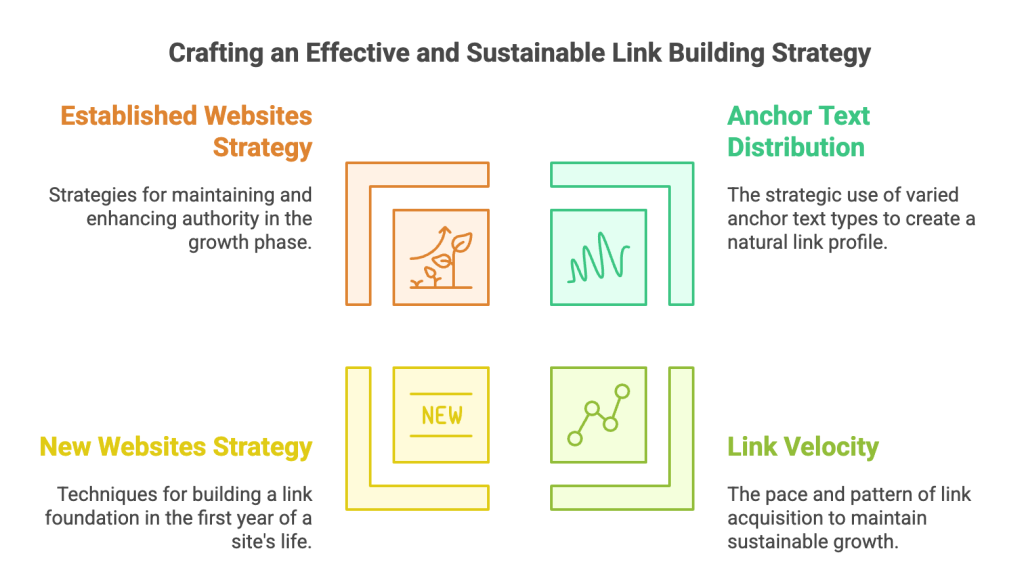
Anchor Text Distribution
The most common problem that can get your website penalized is unnatural link profiles. Search engines will take notice — and not in a good way — if your links look coercive or lopsided.
A winning backlink profile should have diversity, similar to a balanced investment portfolio. Here’s how you can keep your links as organic and eco-friendly as baby seals; Exact match anchors are done. Results today are powered by a balanced approach. Here’s the breakdown:
- Brand and derivatives: as search engines reward brand authority, branded anchors are unavoidable. Variations — like “PawsomeFoods” or “Pawsome Foods store” — create trust, and appear to show authenticity. Better brand presence comes with credibility wherein ranking on a top website becomes much easier. Enter Focus keywords.
- Naked URLs: Naked URLs (e.g., “pawsomefoods.com/dog-food”) help maintain a natural backlink profile. They mimic organic sharing patterns and prevent over-optimization. Search engines recognize these as authentic links, reinforcing domain authority without appearing manipulative or excessively keyword-focused.
- Generic phrases: The generic anchors help with user experience and awareness. Since links are blended into the content naturally, it pushes for clicks without the need for keyword stuffing. This technique mirrors human linkages, which eliminates spam signals and pushes the link profile well into diversity.
- Topical anchors: This substance uses terms that are contextually related to your niche. e.g. “ healthy pet nourishment. They convey relevance to search engines without incurring penalties. This can help increase topical authority when you combine related keywords and help elevate rankings for several related search queries.
- Exact match keywords: Using exact match anchors sparingly helps to avoid penalties for over-optimization. They’re still useful, but overused can seem manipulative. 5-10% would work best for that to make sure that they would always just help the relevance of them on your target keywords and not overly optimize such link building that looks artificial and spammy generally.
Example: If you’re optimizing for “organic dog food,” your anchor text distribution should look something like this:
- PawsomeFoods: Branded anchors work well to build trust and credibility with search engines. Branding is keeping your name the same – this way it signifies the original work and strengthens the brand presence as well. Such a diverse approach helps maintain a natural link-building profile, eliminating the risk of penalty and improving overall domain authority.
- Pawsomefoods. com/dog-food: Naked URLs link to your site in an unoptimized way, so they appear to create a natural backlink profile. Such links appear natural and have active sharing behavior, building domain authority with no excessive targeting of keywords, ensuring and allowing for an even strategy without a nuke or penalty.
- Check out this guide: Using generic anchor text enhances user engagement by interspersing links within the content naturally. Since there are no keywords in these expressions, they limit the chances of optimization overkill. This approach also prompts to click based more on context than a keyword’s positioning, thus giving links a less robotic feel.
- Healthy pet nutrition: Topical anchors help search engines understand the relevance of your content without relying on exact match keywords. By using related terms, you build topical authority, making it easier to rank for broader search queries while maintaining a diverse, natural-looking backlink profile.
- Dog food organic: Use exact match anchors sparingly to not be penalized for over-optimization. Although they confirm keyword relevance, overstuffing can seem manipulative. They should be kept below 10% to make sure that they add positively to your rankings without raising spam alarms.
Link Velocity
Having a proper link-building structure is essential to the importance of a website because link-building is the only way to create authority and maintain that authority. Instead of pursuing sudden, unnatural growth, sustainable practices focus on gradual yet steady progress with little to no risk of search engine penalties. Here is a natural link-receiving strategy for different website phases.
For New Websites (Under 1 Year)
Building a foundation in the first year requires a cautious but steady approach to avoid unnatural spikes in backlinks. The focus should be on earning links from reputable sources rather than mass link acquisition.
- Months 1-3: Secure 3-5 new referring domains from relevant, low-competition websites such as industry blogs, directories, or guest posts.
- Months 4-6: Increase link acquisition to 5-8 referring domains, leveraging niche partnerships, outreach, and high-quality content that naturally attracts backlinks.
- Months 7-12: Scale up to 8-12 new referring domains per month while diversifying sources, incorporating editorial links, resource pages, and niche-specific guest contributions.
For Established Websites (1-3 Years)
After the site was up and running things to normal: the emphasis was basically on keeping up (growth) and solidifying (authority) in the domain. The tenets: Consistency and quality over quantity.
- Build 10-15 quality referring domains month-over-month, balanced between dofollow and nofollow.
- Instead of getting any links that would help you, focus on getting industry-relevant backlinks from authority sites, news publications, and expert roundups in your niche.
- Build up a link profile consisting of editorial links, business citations, high-authority guest posts, and natural outreach in order not to build a pattern that could land a search engine penalty.
A well-planned link-building strategy assists organic growth, improves search visibility, and boosts the domain authority over time. Simply put: if websites do it right and create relevant and authentic content, they don’t need to use tricks to get the top position in Google’s rankings. Tell me if you need adjustments or more information.
Strategic Methods For Superior Optimization
Focusing on what truly matters requires strategic planning and foresight. Every decision should be made with long-term impact in mind.

Technical Foundation
Your website’s technical SEO must be optimized for strong performance. Focus on these key areas:
Core Web Vitals:
- Largest Contentful Paint (LCP): Your largest content piece should load within 2.5 seconds. High bounce rates also affect overall rankings, with subsequent negative impacts on news site user experience. So Optimize images, coding, and caching system to keep the speed.
- First Input Delay (FID): Keeping the delays in the interaction under 100ms. A slack response time frustrates the user and reflects site performance. Reduce JavaScript running time, and also make the server response quicker, to boost interactivity and engagement.
- Cumulative Layout Shift (CLS): Less than 0.1 to prevent layout shifts. Layout shifts frustrate users, especially if they are sudden. Leaving room for dynamic content, setting specific dimensions for media, and preloading fonts can mitigate instability.
- Mobile Responsiveness: Need to cross the 100-mark — Make sure mobile usability is smooth on all devices. Mobile-friendliness increases accessibility and search rankings. Login Tricky Way, Responsive design viewport settings, and touch interaction optimization
Content Quality Standards:
- In-Depth Coverage: Your content should be 1.5 times longer than your competitors’ content. Be sure to do your research and provide a structured form with details and takeaways that are relevant and promote user engagement.
- Original research: Top research or conducting surveys/first aid studies. Skinny = an exclusive insights piece that is not just your average information. Do your research, look at industry statistics, and make fact-based arguments.
- Add Authority with Quotes: Use either industry leaders, academics, or trusted professionals Source with Authority: If you have expert-backed content, it adds credibility to what you publish, making it reliable for the users; as a result, your chance of getting backlinks also increases, elevating your search rankings.
- Regular Updates: Update your content at least quarterly to remain relevant and competitive. Being based on outdated data tends to lower credibility. To keep appearing in searches and engage, we monitor trends, update facts, refine sections, and ensure that all references are correct.
- Use of images and videos: Add relevant multimedia content like images, videos, infographics, etc. Visuals facilitate a better understanding of the content, help lower bounce rates, and increase dwell time as well. Create compressed and properly optimized media files for faster loading, also include alt text and additional accessibility features to cater to all users.
User Experience Enhancements:
- Intuitive Navigation: A clear and logical site structure makes it easy for users to find what they need. Optimize usability with clean-cut menus, breadcrumbs, and internal links, efficiently directing your visitors throughout the site.
- Speed Optimizing: Speed up the load time by optimizing your images, clean coding, and using browser caching. He or she gets frustrated, the user takes off and your ranking then suffers too. These include compressing files, minimizing HTTP requests, and using content delivery networks (CDNs).
- Mobile-First: Design first with mobile users in mind. Most of the users visit the sites using mobile devices. Implement responsive layouts, adaptable fonts, and touch-optimized buttons for easy navigation on any screen.
- Regular Updates: Refresh content at least quarterly to stay relevant and competitive. Outdated information reduces credibility. Monitor trends, update facts, refine sections, and ensure all references remain accurate to maintain search visibility and engagement.
- Use of Interactive Elements: Include a poll, quiz, a clickable element, or something interactive to increase engagement. Encouraging participation and extending session duration helps to indicate to search engines that your site is providing something of value with an engaging experience.
By focusing on these SEO best practices, you improve search performance while ensuring a seamless, high-quality user experience.
Implementation Strategy
Foundation Building (Months 1-3)
- Technical SEO Audit: A technical SEO audit assesses site components such as crawlability, indexing, as well as page speed. Addressing broken links, duplicate content, and incorrect redirects establishes a solid foundation for search visibility and enhances user experience.
- Content Gap Analysis: This application of machine learning finds existing content in your niche and compares it with competitor strategies and user intent. By spotting missing topics and outdated information, they can develop that golden high-value content that attracts organic traffic, targeting what their audience needs.
- Competitor Backlink Review: Gain insights into authoritative domains linking to industry-specific content by analyzing competitors’ backlinks. With this information, you can research and reach out to potential guest posting and link-building opportunities to strengthen domain authority and improve organic rankings.
- High-Value Pages: Building in-depth, informative pages around important topics within the industry is a great way to help establish trust and relevance from a search perspective. These pages should help the site establish authority on a micro level within its niche, so they should be packed with depth, internal links, optimized keywords, etc.
- Brand Mentions: Brand mentions from trusted sites create credibility and online visibility. Consider reaching out to our top authoritative sources (like industry publications, local directories, and social media discussions), to maintain a consistent feel for your brand across platforms.
Growth (Months 4-6)
- Create Power Pages: Develop 2-3 in-depth pages covering key topics to establish authority. Use data, visuals, and expert insights. Interlink with related posts to improve relevance and strengthen internal linking for better rankings.
- Launch Digital PR: Run targeted PR campaigns by sharing research, industry trends, and expert commentary. The domain authority will increase with the backlinks which will help to rank our search visibility high in the SERP.
- Host Expert Roundups: Learn from industry professionals about topical matters. This enhances credibility while inspiring social shares and backlinks. That will grow site experience and credibility as individual authors are authoritative.
- Build Resource Links: Identify authoritative resource pages and suggest relevant content for inclusion. This secures high-quality backlinks, drives referral traffic, and enhances search rankings by positioning the site as a valuable industry resource.
- Fix Broken Links: Replace broken links on other websites with relevant content Outreach to site owners ensures that you reclaim lost link opportunities, improve backlink profiles, and, in effect, strengthen the overall domain authority slowly but surely.
Scaling (Months 7-12)
- Advanced Content: Create in-depth whitepapers, guides, and case studies to address industry challenges. Ensure content is research-backed, actionable, and optimized for engagement to establish thought leadership.
- Industry Partnerships: Work on co-branded content, joint ventures, the establishment of brands or influencer partnerships, and so on. Partnerships grow reach and improve credibility in your market.
- Webinars: Book conferences, webinars, and panels to showcase expertise. It is authority-building, relationship-building, and visibility-building.
- Podcast Appearances: Join relevant podcasts to share valuable insights and reach engaged audiences. This channel builds a sense of credibility and allows for more engaging relationships with prospects.
- Data-Driven Studies: Publish research-oriented studies, surveys,s and reports to offer new insights. Publishing good data builds authority and puts your brand front and center as an industry leader.
Also Read: Benefits of Earned Links for SEO (+15 Best Practices to Acquire Them)
Frequent Errors And Effective Solutions
Over-Optimization Red Flags
Sudden Surge in Backlinks
- Normal: 5-10 new links per week, a sign of organic link-building efforts. These links are passed from various sites over some time, showing true interest in what you are producing, not just a machine creating false clicks.
- Red Flag: Visibly unnatural activity, like links purchased en masse overnight (i.e., 50 or more), automated schemes (influence, etc.). This is considered spammy behavior by search engines; it can result in your site becoming ‘punished’ by lost credibility.
Overuse of Exact-Match Anchor Text
- Normal: A good-angled backlink profile has a balance of all types of angles, branded, generic, and keyword-rich. This change disguises link building, as it alters the way users behave organically, and keeps search engines from marking the site as manipulative.
- Red Flag: When the same, often keyword-heavy, anchor text is repeated across several backlinks, it indicates a manipulation attempt to boost rankings. This unnatural pattern is picked up by search engines which can result in being penalized or not being ranked as high up in searches.
Link Source Consistency
- Normal: Aim for diverse backlinks from various sites, each on different IPs. This is an indication of organic growth and a bona fide linking pattern, as real websites are not likely to use the same hosting infrastructure with each other.
- Red Flag: The same IP address, or the same hosting network, creating several backlinks is an indicator of an organized effort by someone trying to manipulate rankings. This may be flagged as a link scheme by search engines, which could lead to potential penalties.
Recovery Strategies
Immediate Actions:
- Conduct a thorough link audit: Analyze all backlinks, and look for unnatural, spammy, or low-quality links that may damage your ranking and the credibility of your website. Accurate insights are possible only with proper SEO Tools.
- Identify and document all questionable links: Create a detailed list of suspicious links, categorizing them based on their potential risk level. This documentation helps in both internal tracking and when submitting reconsideration requests.
- Prepare and submit a disavow file: Compile a disavow file listing harmful links and submit it to Google Search Console. This signals search engines to ignore those links, preventing penalties from impacting your site’s performance.
- Request reconsideration from the relevant platform: If your website has been penalized, submit a well-documented reconsideration request explaining the corrective actions taken. Ensure transparency and patience, as the review process may take time.
Long-Term Recovery:
- Strengthen your brand presence: Establish authority by consistently producing valuable content, engaging with your audience, and maintaining a strong online reputation. A recognizable brand attracts organic backlinks and long-term credibility.
- Develop high-quality, shareable content: Create valuable resources, such as in-depth guides, research studies, or interactive tools, that naturally earn backlinks from reputable sources and improve your site’s authority over time.
- Build an engaged community: Foster connections through social media, forums, and direct interactions with your audience. Encourage discussions and participation to strengthen relationships and enhance your brand’s visibility.
- Establish genuine industry connections: Network with industry professionals, collaborate on projects, and contribute to authoritative sites. Authentic relationships help generate natural backlinks and improve your site’s trustworthiness.
Building A Resilient Strategy For The Future
As search algorithms evolve, link building is shifting toward a more strategic and quality-driven approach. Based on current trends and Google’s focus on relevance, here’s what to prioritize moving forward.
Emerging Trends
- AI-Driven Evaluation: AI is playing an ever-larger role in how search engines evaluate the relevance and quality of content. Rather than emphasizing link volume, the new AI-driven ranking factors are all about contextual meaning, engagement, and authority, which means that smart link-building is more important than ever.
- Video Backlink Impact: With video becoming more popular, SEO value from backlinks on popular platforms like YouTube and Vimeo will become more powerful. Farther down the road, embedded video links, video description data, etc. will make content more credible for indicated rank, thus making it more engageable and more searchable.
- User Engagement Signals: Link authority will be measured such as dwell time, levels of interactions, bounce rates, etc. Backlinks that contribute to active engagement will be favored over those merely generating clicks without user involvement.
- Brand Mentions Matter: Brand mentions that are unlinked and on authority sites are becoming SEO signals. Thus, Google might view them in a fashion like backlinks as a signal of trust, authority, and topical relevance in the algorithm ranking process.
- Social Media Influence: Social signals are not direct ranking indications; still, high engagement—shares, comments, and discussions—highlights the reliability of the content. Visible social presence grows with time and adds value to SEO.
Adaptation Strategies
- Brand Authority Growth: By building up your credibility on industry sites, forums, and authoritative sites that lead to your site you will create natural link-building backlinks. A prominent brand presence solidifies credibility and drives organic visibility.
- User Experience Focus: Optimizing for website speed, mobile responsiveness, and readability means increased engagement. An integrated user experience encourages visitors to stay on the site longer and reduces bouncing, which increases the SEO worth of incoming links.
- Diverse Content Formats: The use of videos, infographics, and interactive content broadens the scope of your outreach and increases the chances of creating high-value backlinks. Great content naturally begs to be shared — by media — industry leaders — and niche communities.
- Industry Relationships: Networking by establishing relationships with professionals, guest blogging, and outreach creates spontaneous link-building opportunities. Building your credibility in collaboration with reliable sources brings you strength in your domain.
- Content Consistency: A strategy of consistently publishing high-quality, research-backed content builds trust, integrates organic backlinks, and caters to Google’s inclination for high-quality, user-focused content, hence establishing long-term SEO success.
Also Read: Link Relevance: What is it And Does it Still Matter?
Enhance Your Website Authority Through Effective Link-Building
SEO is ever-evolving, and keeping up with the latest updates and trends is a must. Given the evolution of SEO, link-building techniques need to change to keep up with the best practices and market shifts.
A healthy backlink profile usually has links from high-quality and relevant websites. This is no longer just a case of getting links — but making sure they provide an uplift to overall SEO performance.
How a Strong Backlink Profile is Built
- Step 1: Conduct a thorough industry analysis, identify authoritative sites, and establish connections to secure valuable backlinks.
- Step 2: Utilize tools like Ahrefs, SEMrush, and Moz to monitor backlink profiles and manage link-building campaigns. Regular audits help assess whether adjustments are necessary to maintain a strong profile.
- Step 3: Focus on diversifying backlinks while eliminating harmful links to enhance search engine credibility.
Backlinks are still an important part of SEO in 2025. Search engines rank them for their quality, relevance, and authority, not the quantity. A clean backlink profile has a direct correlation with rankings and site performance!
For those who are struggling with your backlinks profile, professional help will make sure that your SEO growth, is sustainable. Building domain authority and long-term success with a strategic approach to link building.
Conclusion
For 2025 SEO success, the quantity of backlinks will not matter, but their quality will. Optimized based on authority, relevance, and the quality of a backlink is favored by search engines over spam and excessive links. But as a rule of thumb, a clean and strong backlink profile with links from good sources will increase ranks. Follow these four tips for link building instead of targeting a particular number. The best way to reach your SEO goals is to find the right balance between backlinks, on-page SEO, and user experience.
FAQs
How many backlinks are needed to rank on Google in 2025?
There is no set number of backlinks required to rank on Google. The focus should be on high-quality, relevant backlinks rather than quantity. Some websites can rank with a few authoritative links, while competitive niches may require more. Google prioritizes backlinks from trustworthy, relevant sources that add value to user experience.
What kind of backlinks improve rankings the most?
The most valuable backlinks come from authoritative, industry-relevant websites. Editorial links, guest posts, niche directories, and backlinks from government or educational sites carry significant weight. Contextual backlinks placed within high-quality content are also effective. Google values backlinks that are naturally earned rather than artificially placed through manipulative link-building practices.
How long does it take for backlinks to impact rankings?
The impact of backlinks on SEO varies based on factors like link authority, competition, and Google’s indexing speed. Typically, it can take weeks or even months for backlinks to influence rankings. Consistently earning high-quality links and maintaining a strong content strategy helps accelerate the process, ensuring long-term SEO growth and search visibility.
What’s the best backlink strategy for 2025?
The best strategy is to prioritize quality over quantity. Focus on earning backlinks from authoritative, niche-relevant websites through guest blogging, content marketing, and digital PR. Create valuable, shareable content that naturally attracts backlinks. Regularly audit your backlink profile, disavow toxic links, and maintain a diverse, high-authority link-building strategy for long-term SEO success.

















